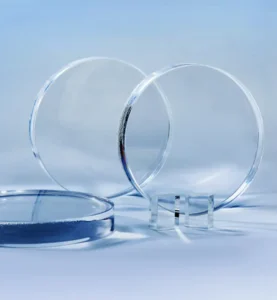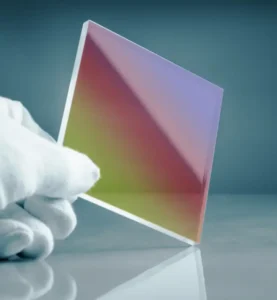Like any other glass type, optical glass is famous for its flawless elegance and excellent light-related properties. Moreover, it is part of various glass lenses in our daily lives.
From manufacturing eyeglasses to controlling the refractive indices of the materials, optical glass is a big deal.
Do you want to know this glass type in detail? Today, we will dig deeper into optical glass and understand how it helps various industries.
What is optical glass?
Optical glass is a unique and special glass constructed to control light activities. From light transmission to reflection, it controls all aspects effectively.
Compared to other glass types, it is different. It can help control the light. Other glass types can either distort or scatter light, unlike controlled reflection.
Doing so makes optical glass suitable for prism and microscope glasses.
Properties of optical glass
Optical glass types come with multiple unique features. High precision and customization help create a new pace for optical devices.
Optical glass can feature the following properties.
Refractive Index
The Refractive Index is the bending power of the light when it enters from a vacuum into the medium. This refraction can provide better control over different applications and make a place in the focal lengths of other lenses.
Based on needs, manufacturers can further customize the refractive indices of the optical glasses.
Dispersion
Dispersion is the conversion of light into its various color components. It helps demonstrate the different wavelengths of light in the single-light option.
The Abbe number defines the dispersion. For example, a high Abbe number means a lower dispersion. It is suitable for multiple applications to create sharp images with better accuracy.
Transparency

Transparency is the ability to transmit light without absorption. You can see through a transparent object effectively.
Various applications need the transparency of the optical glass. So, it is a crucial property of the optical that makes it suitable across multiple industries.
Chemical Stability
Optical glass construction makes it more resistant to damage by chemicals such as alkali, acid, or moisture. The constant employment of glass materials in such conditions keeps it safe too.
Because of the chemical stability, optical glass stands as a perfect candidate for an industrial or outdoor setting. It is less prone to damage and easier to maintain also.
Thermal Stability
Optical glass is also a fine candidate for thermal applications. Its low thermal coefficient does not let it expand easily, even at higher temperatures. Thus, the optical glass is also helpful in applications where heat is constant.
It stays stable without deforming its shapes.
High Power Laser Systems deploy the optical glasses because of their better stability factor.
Benefits of optical glass
Optical glass can find an advantage related to its general stability and easy light control. Here is what is to be noted for the testing of optical glass.
High transparency
It is familiar with the selective transparency of the optical glass. It reflects nearly 99 percent of the light with minimum absorption.
So it is apt for all the applications that require transparency. From cameras to microscopes, all the obligatory applications necessarily require the controlled transparency of the optical glasses.
Better control over the refractive index
The refractive index can be a critical point for many applications. Still, the optical glass enjoys a refractive index of customized usage.
In this refractive index, manufacturers can alter according to the need of applications. In the case of a camera, a sharp image capturing is necessary. The customized refractive index of the optical glass helps in easy working and light controlling in an easy manner.
Low dispersion
And one more thing: if you are applying light, refraction and dispersion, then this is meant to be. Optical glass has an in-built low dispersion of light, which means it doesn’t split into its constituents, ensuring a better journey and control of the light.
On the dispersionless color accuracy; better usability of the various applications.
High mechanical strength

Do not forget optical glasses in cases where you are a big fan of annealed or heat-strengthened glass. They have good strength and scratch resistance; therefore, the surface is smooth and very noble when utilized in different applications in the making of things.
The glasses are not shaped even a little by deforming forces. They remain unbreakable when thrown from a height. In this way, optical glasses are technically a favorite choice for a number of applications in our day-to-day lives.
Durability
Are you living in extreme environmental conditions? Don’t worry; sudden environmental hits shock us, but optical glasses remain in their original condition. If there is humidity or chemical exposure, they remain safe without any damage.
Such resistance features minimize the hassles of maintenance with cost reduction.
High customization
Welcome to the full-fledged customization of the optical glasses. They are known for their light control but with excellent customization features. For example, you can control the refractive indices and handle the overall refraction. Plus, the control of reflective and dispersion properties is also a part of customization.
Based on your glass needs, you can tailor the properties of your optical glasses. Minimize your hassles for stability. And deploy them in various applications without a second thought.
Applications of optical glass
Do you want to know all the applications where optical glass plays a crucial role? First of all, think of the optical industry. It stands as the biggest deployer of optical glass.
Take a quick overview of the different applications of optical glass.
Consumer Electronics
Consumer electronics includes various products ranging from TVs to smartphones.
- Smartphone Camera. Have you ever noticed your smartphone cameras? They comprise optical glasses and make sharp photos.
- Display and Screens. Many LCD screens and TVs have employed optical lenses in their systems. It helps clear up the blurred photos and run the videos with HD quality.
- AR and VR systems are the future devices. Guess what? They also use optical lenses to elevate their experience and make it more immersive for the users.
Imaging Systems

Imaging systems have excessively deployed optical glasses in the systems. This is due to their sharp image capture and the elimination of blurred images.
- Camera Lenses need to capture a high-quality image. It is only possible when you need high-end lens parts. Optical glass provides this facility to the camera by improving its image-taking capacity.
- Microscopes. Zooming is a necessary feature for the microscope to view small organisms. It is only possible when you have an optical glass with high-end focusing capacities. Therefore users can better focus on the pathological slides in the lab or find the microorganisms effortlessly.
- Telescopes. In contrast to microscopes, telescopes look at objects miles away in the sky. Better focusing with the help of optical glass also makes this case easy for the experts.
Optical Lenses

It is not just the optical glass you must know but also the optical lenses. Optical glass makes the lens and elevates the accuracy of the hunters.
- Binoculars. Catch the bird or focus on your targets. Guess what? In the Olympic shooting competition, competitors use binoculars to elevate their focus on the target. Optical lenses enhance the focus on the target and improve the targeting process.
- Rangefinders. If you are a golfer, range finding is a crucial task for hitting the targets. Moreover, hunting and military applications also employ the rangefinders. These comprise the optical glass and assist in exploring the targets better.
- Periscopes. Are you a mariner? Well, periscopes are ideal components for finding submarines or other objects in the sea. Say thanks to the optical glass that makes its essential components and manufactures the best quality periscopes.
FAQs
-
What is the difference between optical glass and glass?
A simple glass can be quite different from the optical one. For example, optical glass is transparent and unique compared to glass. Moreover, it is scratch-resistant and has superior light control and transmission. Sometimes, it can be denser than simple glass materials.
-
Why is optical glass so expensive?
The answer is hidden in its various features and technical manufacturing. Here are a few controlled features that elevate its prices.
- It has to go through multiple processing techniques.
- The hardness and durability of the material owe to better finishing.
- Precision and accuracy of the material can involve complex manufacturing processes. So, overall, optical glass is expensive.
-
What material is optical glass?
Optical glass is also manufactured like the other materials. However, you can find some central components like the oxides. The most common oxides include silica (SiO2), boron oxide (B2O3), and alumina (Al2O3). However, it can comprise 50+ other materials based on the optical glass features and customization.
Conclusion
Do you want to control the features of your optical glass? Well, make it more suitable as per your needs. Dig out the custom optical glass from the top suppliers. Check the quality and pricing before you opt for it.
Shenxun Glass Manufacturer is one of the best choices for the glass industry. Our customized optical glass provides you with complete control over the material. Plus, you can modify its different features as per business needs. Try it right away!
